Sunday, April 18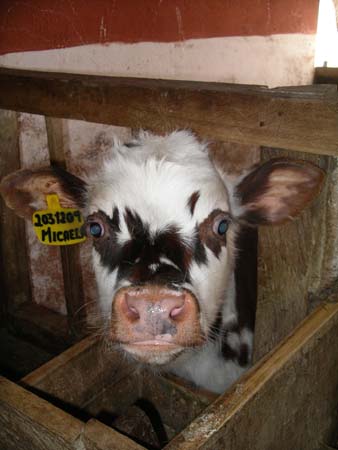
Steve: We have never been much of a horseback riding
family, so we're not exactly sure how we all decided to include riding as
part of our trip to Ecuador. Before today, David had never been on a horse.
Paula said she was scared of horses and had no desire to ever ride one. Katie
has ridden a few times as part of Girl Scouts, but never outside a ring.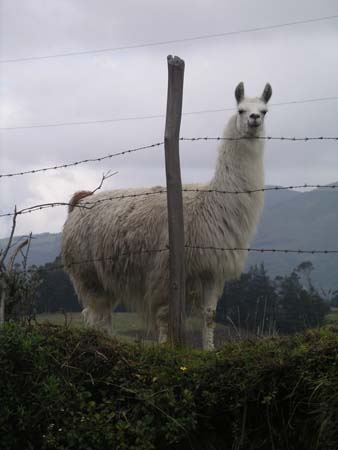 I hadn't been on a horse since a high school summer long ago in Indiana.
I hadn't been on a horse since a high school summer long ago in Indiana.
I guess that since horseback riding is such a major activity here, we decided that we should give it a try. As it turned out, we were very happy we did!
Our destination today was an area called "Avenue of the Volcanoes",
so named because of the four large volcanoes that line the sides of this large
green valley. We left Quito and drove for 1 ½ hours to a large hacienda
called Terra del Volcan, located just outside the town of Machachi. This hacienda
sits on 4,500 hectares, and is a working farm that includes dairy cows, bulls
that are raised for bullfighting, llamas and 32 "Panama Horses"
for riding. Th ese
horses are specially bred so that they can endure these high altitudes - the
hacienda sits at an altitude of 10,000 feet, and other horses tire much too
quickly. The farm also grows potatoes and several other vegetables.
ese
horses are specially bred so that they can endure these high altitudes - the
hacienda sits at an altitude of 10,000 feet, and other horses tire much too
quickly. The farm also grows potatoes and several other vegetables.
After arriving at the hacienda, we enjoyed a quick tour of the farm and some traditional Canelazo Tea, made with cinnamon and canelazo which is a fruit similar to tomatoes. Similar to Hacienda Zuleta, this hacienda has only recently opened its doors to tourists. Many people simply come for day trips to ride the horses in the beautiful surroundings.
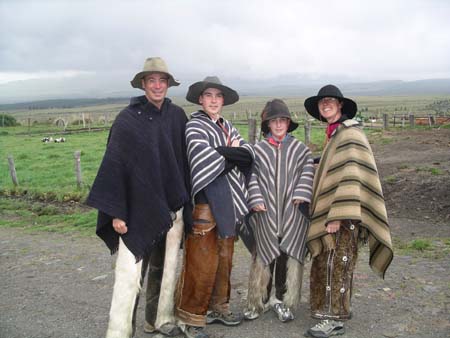 We
then all suited up just like real "chagras" (Ecuadorian cowboys).
This included wool ponchos, sombreros and chaps. We all got a good laugh out
of how we all looked, but given today's brisk and sometimes rainy weather,
we were all happy to
We
then all suited up just like real "chagras" (Ecuadorian cowboys).
This included wool ponchos, sombreros and chaps. We all got a good laugh out
of how we all looked, but given today's brisk and sometimes rainy weather,
we were all happy to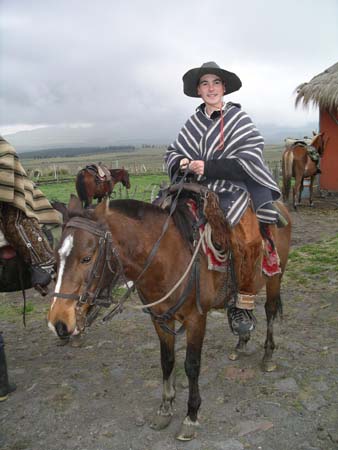 be so well protected. Before setting out, we received a briefing on the ride.
It didn't take long for us to realize that this was going to be the real thing
(and not the lazy trail rides that Paula and I remember from the times that
we had been on horses long ago). We received instructions on all aspects of
how to control and guide our horses - including how to canter! It was too
late to turn
be so well protected. Before setting out, we received a briefing on the ride.
It didn't take long for us to realize that this was going to be the real thing
(and not the lazy trail rides that Paula and I remember from the times that
we had been on horses long ago). We received instructions on all aspects of
how to control and guide our horses - including how to canter! It was too
late to turn 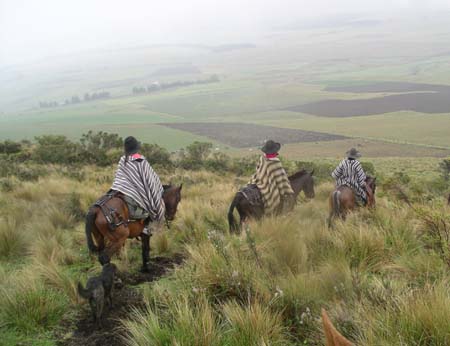 back,
so we listened, saddled up, and set out on our way…
back,
so we listened, saddled up, and set out on our way…
Our ride turned out to be a really wonderful experience. It was just the
4 of us, along with Henr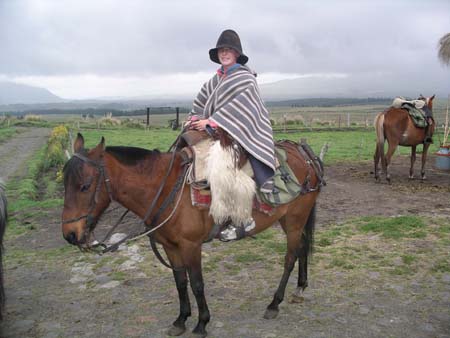 y
and our trail guide. We climbed along trails and through open pastures up
to an altitude of 11,500 feet. The scenery all around was spectacular - we
were high in the Andes Mountains with open views of valleys all around. The
only unfortunate thing was that the cloudy weather occluded what would have
otherwise been an even more wonderful view - we were riding right in the shadows
of the huge snow-ca
y
and our trail guide. We climbed along trails and through open pastures up
to an altitude of 11,500 feet. The scenery all around was spectacular - we
were high in the Andes Mountains with open views of valleys all around. The
only unfortunate thing was that the cloudy weather occluded what would have
otherwise been an even more wonderful view - we were riding right in the shadows
of the huge snow-ca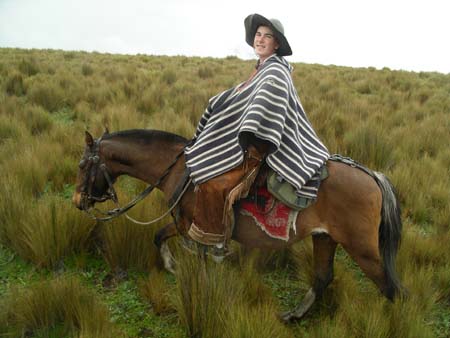 pped
Cotapaxi Volcano.
pped
Cotapaxi Volcano.
After about 15 minutes of steady climbing, we stopped in an enclosed area
and our trail guide gave us some background about the bulls that are raised
here. Bullfighting is common in Ecuador, and several large farms like this
raise bulls. We learned abou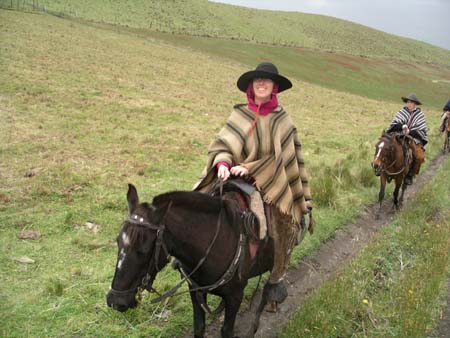 t
how they are fed, bred and cared for. That was all fine, but we hadn't realized
where this was all heading. Next we received notice that the rest of our ride
would be in areas where the bulls in fact graze freely. We were told that
although it's extremely rare, there was some risk that one of these highly
territorial and aggressive animals could decide to charge us. If indeed this
happened, the first thing we should do is run our horse uphill, away from
the bull (assuming, of course, we could find a nearby
t
how they are fed, bred and cared for. That was all fine, but we hadn't realized
where this was all heading. Next we received notice that the rest of our ride
would be in areas where the bulls in fact graze freely. We were told that
although it's extremely rare, there was some risk that one of these highly
territorial and aggressive animals could decide to charge us. If indeed this
happened, the first thing we should do is run our horse uphill, away from
the bull (assuming, of course, we could find a nearby 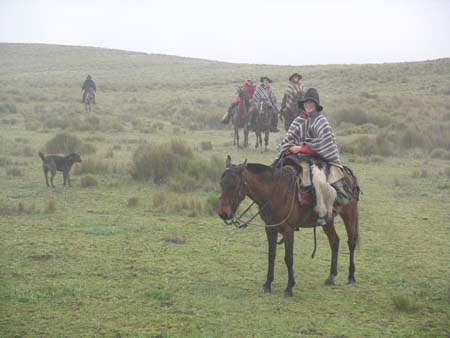 hill
to run up). If for some reason we couldn't get our horse running up a hill,
our instructions were to dismount, leave our sombrero and poncho on the ground,
and run, run, run. Great… We found it curious that there was no mention
of bulls before we st
hill
to run up). If for some reason we couldn't get our horse running up a hill,
our instructions were to dismount, leave our sombrero and poncho on the ground,
and run, run, run. Great… We found it curious that there was no mention
of bulls before we st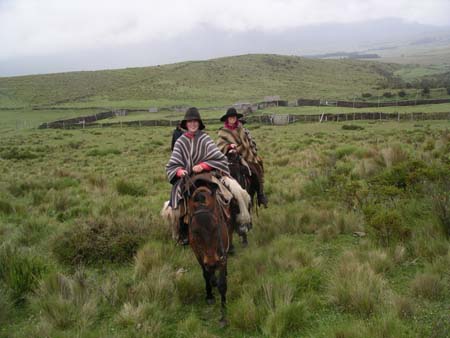 arted
our ride…
arted
our ride…
Sure enough, after another 10 minutes of riding, we saw some bulls running along a ridge ahead of us. Our trail guide didn't seem concerned, so neither were we. He had told us that groups of bulls weren't really dangerous - solitary bulls were the only things to worry about. Later on our ride, we saw a large group of bulls that seemed to be keeping an eye on us, but they were clearly too far away to be of any concern. That was a good thing.
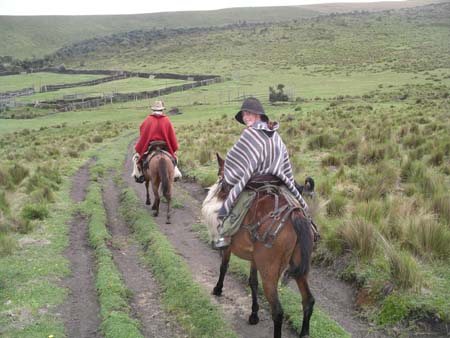 After
climbing up to the 11,500 foot level, our guide told us that we were free
to "gallop" (he really meant canter) - all we needed to do was give
our horses a quick kick and hold on. We weren't really sure that we wanted
to do this, but the moment that our guide took off all of horses immediately
broke into a run in hot pursuit. Here we were, all cantering in a flat, open
pasture, with fantastic views all around. It was wonderful! We all had a good
laugh thinking about the fact that this was David's first time ever on a horse.
Our guide gave us several additional opportunities to canter today - it was
great!
After
climbing up to the 11,500 foot level, our guide told us that we were free
to "gallop" (he really meant canter) - all we needed to do was give
our horses a quick kick and hold on. We weren't really sure that we wanted
to do this, but the moment that our guide took off all of horses immediately
broke into a run in hot pursuit. Here we were, all cantering in a flat, open
pasture, with fantastic views all around. It was wonderful! We all had a good
laugh thinking about the fact that this was David's first time ever on a horse.
Our guide gave us several additional opportunities to canter today - it was
great!
One of the best things about today's ride was that the terrain allowed us
to guide our horses freely over large open areas, often through beautiful
tufts of long grass. While there were some established trails that we followed
through the pastures, we were also able to ride where we wanted, often side-by-side.
This was far different from the trail rides that Paula and I 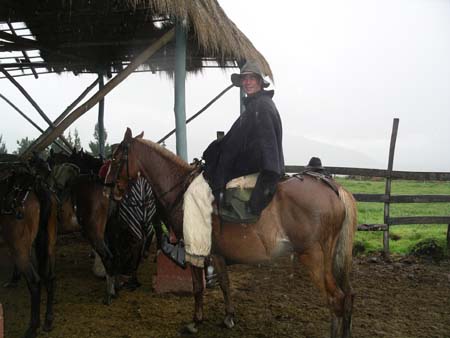 remember
where your horse simply followed the horse in front of it for the entire way.
The area we rode in today was also a primary path used by the Incas in traveling
between Cuzco in Peru (the Inca's political center) with Quito (the commercial
center).
remember
where your horse simply followed the horse in front of it for the entire way.
The area we rode in today was also a primary path used by the Incas in traveling
between Cuzco in Peru (the Inca's political center) with Quito (the commercial
center).
Finally, after about two hours of riding (which was absolutely long enough for our rears us to be in the saddles), we headed back to the hacienda for a wonderful lunch that included traditional potato soup with avocado, pork and corn.
The drive this afternoon to Santo Domingo was long and took us along a very
windy road as we descended first through a cloud forest and eventually down
to a lowland 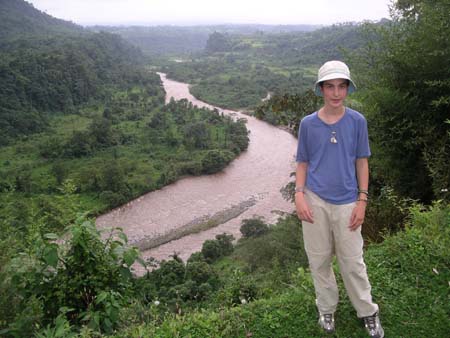 tropical
forest. When we arrived, the air was noticeably warmer and more humid than
anything we've felt in Ecuador so far. We were now at an altitude of only
500 feet - until now, we had spent all our time at 10,000 feet or above.
tropical
forest. When we arrived, the air was noticeably warmer and more humid than
anything we've felt in Ecuador so far. We were now at an altitude of only
500 feet - until now, we had spent all our time at 10,000 feet or above.
Tomorrow we will have our first family experience with white water rafting. We'll be meeting with a special rafting guide who is going to explain the various river conditions and options for the day - it should be great fun!
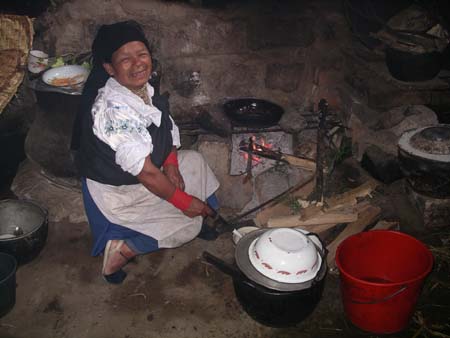
Katie's Kwick Kwacks: My Impressions of Ecuadorian Villages and People. As we stepped into darkness of the smoky home, we couldn't help but smile. No matter how far across the world you go, we realized, the overall life style of the people which we have seen on this trip, remains the same. Inside this traditional and typical Ecuadorian home, we immediately noticed the dirt floor, fire, smokiness, and darkness of the family's one-room house. It had no windows, little ventilation, and no sleeping beds. The two women slept on reed mats, and stored grain in three-hundred year old Incan pots. They cooked food on an open fire, and ate on their dirt floor. The house was made of dried adobe bricks that anyone could have easily picked through in less than an hour. This was very typical for us.
Despite these obvious similarities, however, we have found that each place
has its own special charm. A moment after we entered the house we found it.
All of a sudden we heard something scurry across the floor. I though it was
a mouse, but then more began to run. I peered under a pot and found at least
15 guinea pigs staring back at me. I back pedaled-I had never heard of anyone
who owned that many guinea pigs before. Before I 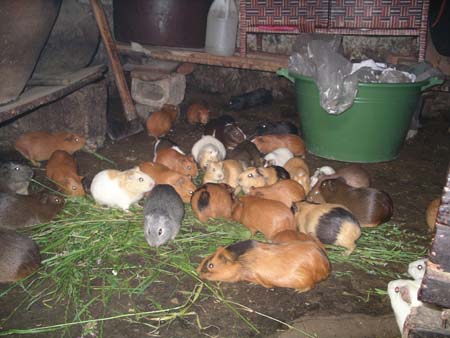 could
say another word, I turned and found 20 more adults and babies, scampering
around the back of the house. The women cooking gave me a crooked toothed
smile and said, "Muchos (many)"! I gave her a nervous chuckle and
uttered "Si." Before I knew it the woman threw a large bundle of
greens toward the little creatures, and they all darted over for their lunch.
I took advantage of the opportunity and asked our guide, "Why do they
have so many guinea pigs"? He gave me an odd look and replied "They
have to prepare lots of them for fancy occasions." "You mean they…eat
them"? He looked at me straight in the eyes and said, "It's a tradition."
could
say another word, I turned and found 20 more adults and babies, scampering
around the back of the house. The women cooking gave me a crooked toothed
smile and said, "Muchos (many)"! I gave her a nervous chuckle and
uttered "Si." Before I knew it the woman threw a large bundle of
greens toward the little creatures, and they all darted over for their lunch.
I took advantage of the opportunity and asked our guide, "Why do they
have so many guinea pigs"? He gave me an odd look and replied "They
have to prepare lots of them for fancy occasions." "You mean they…eat
them"? He looked at me straight in the eyes and said, "It's a tradition."
During our time spent in villages and communities in Ecuador, we have noticed
many similarities and differences between the life style of the people here
and those of the people in Asia. One of the similarities we have noticed between
the life styles in these two continents are the various ethnic groups and
their unique dress. Both here and in Asia we have been able to identify which
group many of the people are a part of by just looking at their clothing.
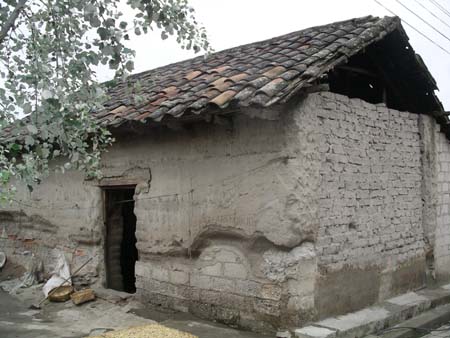
Another major similarity between these life styles is the living conditions of the people. This includes the style and size of their homes, their cleanliness, health, possessions, education, and labor. We have noticed all the people here and in Asia work extremely hard in the areas of physical labor. Supporting your family in these countries involves carrying vegetables, fruit, and corn in heavy packs, delivering water and gasoline on your back (sometimes bigger and heavier than you), and working in the fields through heat and exhaustion. We have also seen many people raising live stock, and girls less than four years old doing loads of laundry in the drains.
The most amazing thing, however, is how hard the old men and women here and
in Asia work. It seems that there is no concept of retirement in these countries,
and the older you get the more you carry. All throughout our travels in Asia
and here we have seen women over eighty years old still turning soil with
heavy hoes, stretching their backs down to their knees to transplant rice,
and carrying unbelievable loads on all areas of their body. Despite this overdose
of physical labor, however, they all still smile, have fun, 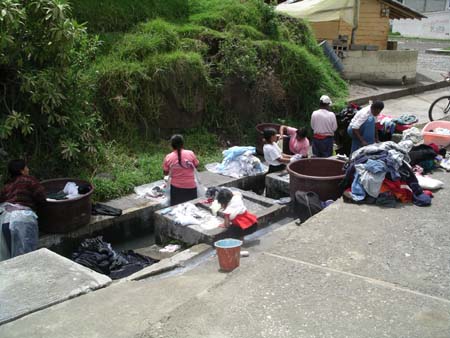 and
many live longer than an average American. Some have money for machinery we
are told, but they choose not to use it. If their ancestors all lived happily
in these traditional ways, why can't they?
and
many live longer than an average American. Some have money for machinery we
are told, but they choose not to use it. If their ancestors all lived happily
in these traditional ways, why can't they?
Despite the many similarities in people and life style in Ecuador and the countries we visited in Asia, there are still a few differences among them. One major difference between these life styles is the religion that the people practice. In just about every place we visited in Asia, Buddhism and Hinduism are the primary religions, and play large roles in the people's lives. There are several shrines throughout the villages and homes. Here, however, we have had a major shock of Christianity. In most of the villages and towns there is at least a small public square with a Spanish church. Even though these religions are very different, we still notice that the people in both places highly respect their ancestors.
Another difference we have observed between these lifestyles is the materials of the homes. Many of them here are made of cement and the streets are made of either tar or cobblestone-in Asia, however, many homes were made of bamboo and the streets were unpaved. Despite the looks on the outside, however, the insides of the homes here in Ecuador and Asia are very similar to the one I described in the first paragraph. We have also observed some differences in transportation here. In most of Asia we have seen people getting around and carrying things on bikes, motorcycles, and carts. Here, however, everyone seems to carry things by hand. Instead of motorcycles and bikes, people get around by walking or using the widespread public buses.
Exploring daily life has been one of the highlights of our entire trip. We have found visiting the local villages in each country we visit to be a fascinating and exciting experience. As we continue to learn about daily life in the countries we visit, we hope to be able to compare them to one another and gain a greater understanding of the world around us.
